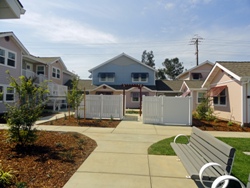
Lowering Utility Bills for a Multi-family Development

In 2003, Sacramento|Yolo Mutual Housing Association acquired a 3.5-acre parcel in the McClellan Redevelopment Area of a former air force base. Part of a Special Planning Area, Mutual Housing at the Highlands was planned as the nonprofit’s first development for the homeless as well as its usual target—working families of modest means.
Of the 90 units, 66 were planned for the homeless. Although these residents would have subsidized housing and some government assistance, in general, they would have extremely low income.
Keeping the cost of utilities in their 500-square foot efficiency units to a minimum was very important. This was true even in Sacramento, Calif., a region that usually gets over 100 degree days in the summer and freezing nights in the winter.
Even though the complex has a very narrow North-South axis, we were able to site most of the units on a north and south orientation to conserve energy.
We also used R-21 insulation in the wall, the highest rated insulation that would fit in the cavity.
High-performing dual-pane windows were installed throughout the complex. Since south, east and west facing windows often let in a lot of heat in summer, Mutual Housing was able to install windows with advanced glass that blocks summer heat while still providing natural light to the interior.
One of the goals was to have the most efficient heating and air conditioning system available within the project budget.
We looked at three types of systems: A traditional split system, a ground-source heat pump and a ductless system called a mini-split heat pump.
Traditional split systems with ducts, furnaces, and outdoor condensing unit would have required a lot of space, and space was at a premium on this project. While the ground-source system would have been very efficient, the cost of drilling wells and installing piping in the ground was too high.
The mini-split system has an outdoor heat pump and an indoor fan coil. The heat pump is small enough to mount on an external wall, while the fan coil is installed high on an internal wall. A blower in the fan coil draws in apartment air to cool it or heat it, as necessary, then blows the air high across the apartment space. Hidden refrigerant lines connect the fan coil to the heat pump, which provides heating or cooling as needed.
Even though this system is relatively new to the U.S., one of our architects recently had worked with it. The mechanical engineer, Marcus Romani of Sacramento, CA-based Meline Engineering Corporation, also was familiar with the ductless system as was the project manager of the general contractor, Chico, CA-based Sunseri Construction, Inc. Because it was less expensive to install yet highly efficient, it made perfect sense for these small apartments.
Before the decision could be finalized, however, we had to convince the developer, Mutual Housing. Even though the Highlands would be its 15th community in the region, they had never used it before. They wanted to make sure it was the best, long-term choice, especially since someone in a wheelchair had to be to operate equipment mounted high on the wall.
Because the heating and air system was so new to this country, there were concerns about the mounting and other details. The problem was solved when Bernard Keck, Sunseri’s senior project manager originally from France, said he had installed one himself.
Eventually we settled on a thermostatically controlled model from Fujitsu with an average Seasonal Energy Efficiency Rating (SEER) of 25, a high efficiency rating without too much additional cost.
We also planned to obtain a green certification from Build It Green. While going through their multifamily checklist, we discovered that if we went to a higher-efficiency system, it would give us a significant boost in points. Naturally, we decided to go for the higher rating.
We thought we were ready to roll, but then, we found out that the model we ordered was no longer available. We had to switch to a model by Mitsubishi. While the efficiency was slightly lower, “…we still were in the high-to-middle range,” said Marcus Romani, P.E., senior mechanical engineer at Meline Engineering.
As Mitsubishi was getting ready to ship the units, the March 11th earthquake hit. We were relieved to hear that the manufacturer of the mechanical unit was fine, but we soon found out that the computer chip manufacturer had been hit by the tsunami—and was no longer in operation.
We were not only convinced that the ductless system was the best solution, but the apartments had been designed with this system’s specifications in mind.
We waited for one or two days while the supplier tried to find a chip or a model with the same electrical and space requirements. Once systems from Mitsubishi became available, contractors around the globe were vying for them. We ordered immediately.
The Sacramento City and County Housing Authorities Utility Allowance for a similar apartment is $73.00. Our energy consultant, Sean Armstrong of Arcata, CA-based Redwood Energy, calculated the utilities would be $51.00, a savings of more than 30 percent. Keck thinks the system could cost half to run compared to another.
Construction recently was completed at Mutual Housing at the Highlands and residents began moving in.
The formerly homeless residents also will have on-site social services to help them get back on their feet. Help includes getting food, clothing and basic household goods as well as medical attention, treatment for mental illness and substance abuse. Job training to integrate them back into society also will be available.
The village community has 66 efficiency units, plus12 studio apartments above a garage and 12 3-bedroom apartments for other residents.
Mutual Housing staff expect the multifamily development to be certified green by the end of the year.
Cynthia Easton, AIA, LEED, AP, is the principal architect and owner of Cynthia Easton Architects, which specializes in commercial, including publicly funded developments such as affordable housing and public utilities as well as residential.